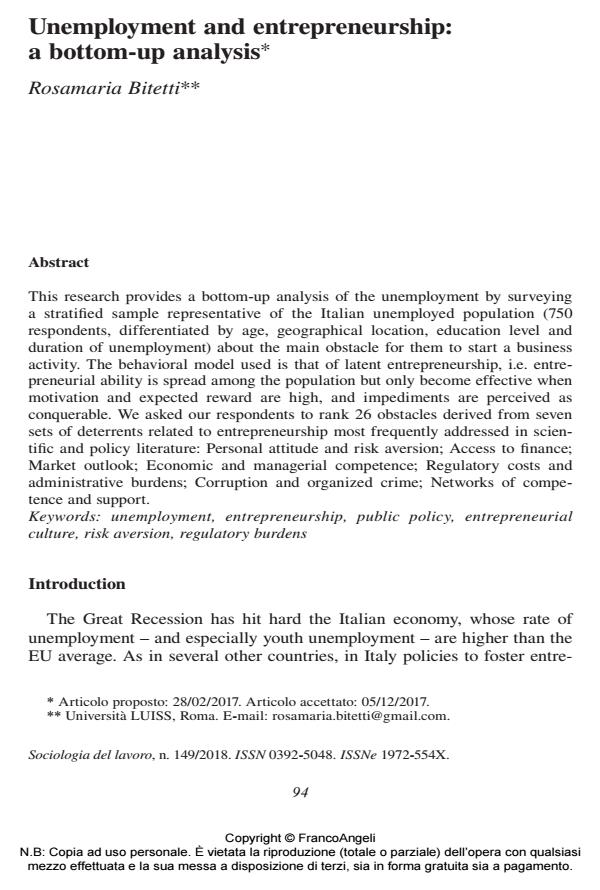Unemployment and entrepreneurship: a bottom-up analysis
Titolo Rivista SOCIOLOGIA DEL LAVORO
Autori/Curatori Rosamaria Bitetti
Anno di pubblicazione 2018 Fascicolo 2018/149
Lingua Inglese Numero pagine 24 P. 94-117 Dimensione file 170 KB
DOI 10.3280/SL2018-149007
Il DOI è il codice a barre della proprietà intellettuale: per saperne di più
clicca qui
Qui sotto puoi vedere in anteprima la prima pagina di questo articolo.
Se questo articolo ti interessa, lo puoi acquistare (e scaricare in formato pdf) seguendo le facili indicazioni per acquistare il download credit. Acquista Download Credits per scaricare questo Articolo in formato PDF

FrancoAngeli è membro della Publishers International Linking Association, Inc (PILA)associazione indipendente e non profit per facilitare (attraverso i servizi tecnologici implementati da CrossRef.org) l’accesso degli studiosi ai contenuti digitali nelle pubblicazioni professionali e scientifiche
This research provides a bottom-up analysis of the unemployment by surveying a stratified sample representative of the Italian unemployed population (750 respondents, differentiated by age, geographical location, education level and duration of unemployment) about the main obstacle for them to start a business activity. The behavioral model used is that of latent entrepreneurship, i.e. entrepreneurial ability is spread among the population but only become effective when motivation and expected reward are high, and impediments are perceived as conquerable. We asked our respondents to rank 26 obstacles derived from seven sets of deterrents related to entrepreneurship most frequently addressed in scientific and policy literature: Personal attitude and risk aversion; Access to finance; Market outlook; Economic and managerial competence; Regulatory costs and administrative burdens; Corruption and organized crime; Networks of competence and support.
Durante una crisi economica le politiche a sostegno dell’imprenditorialità sono im-portanti. Questa ricerca si propone di migliorare la definizione del problema of-frendo un’analisi dal basso, intervistando un campione stratificato e rappresentativo dell’universo dei disoccupati in Italia. A 750 partecipanti (differenziati per età, zona geografica, livello di istruzione e durata della disoccupazione) è stato chiesto qual è l’ostacolo principale per cui non avviano una loro impresa. Abbiamo chiesto ai nostri soggetti di classificare 26 ostacoli, derivanti da sette insiemi di deterrenti all’imprenditorialità frequentemente utilizzati nella letteratura scientifica e nella policy: Attitudine personale e avversione al rischio; Accesso al credito; Situazione del mercato; Competenze economico-manageriali; Costi regolatori; Corruzione e crimine; Reti di competenze e supporto.
Parole chiave:Disoccupazione, imprenditorialità, public policy, cultura imprenditoriale, avversione al rischio, costi regolatori
- L'innovazione sociale nelle politiche urbane. Un caso studio nel contesto italiano Luca Tricarico, Rosamaria Bitetti, Maria Isabella Leone, in TERRITORIO 96/2021 pp.108
DOI: 10.3280/TR2021-096010 - The Nexus of Social Cause Interest and Entrepreneurial Mindset: Driving Socioeconomic Sustainability Rob Kim Marjerison, Rongjuan Chen, Yinan Lin, in Sustainability /2021 pp.13558
DOI: 10.3390/su132413558 - Economic Factors Influencing Entrepreneurial Activities: Literature Review Amineh Zivari, Mohsen Mohammadi Khyareh, Reza Mazhari, in Roshd -e- Fanavari /2020 pp.32
DOI: 10.52547/jstpi.20815.16.62.32
Rosamaria Bitetti, Unemployment and entrepreneurship: a bottom-up analysis in "SOCIOLOGIA DEL LAVORO " 149/2018, pp 94-117, DOI: 10.3280/SL2018-149007